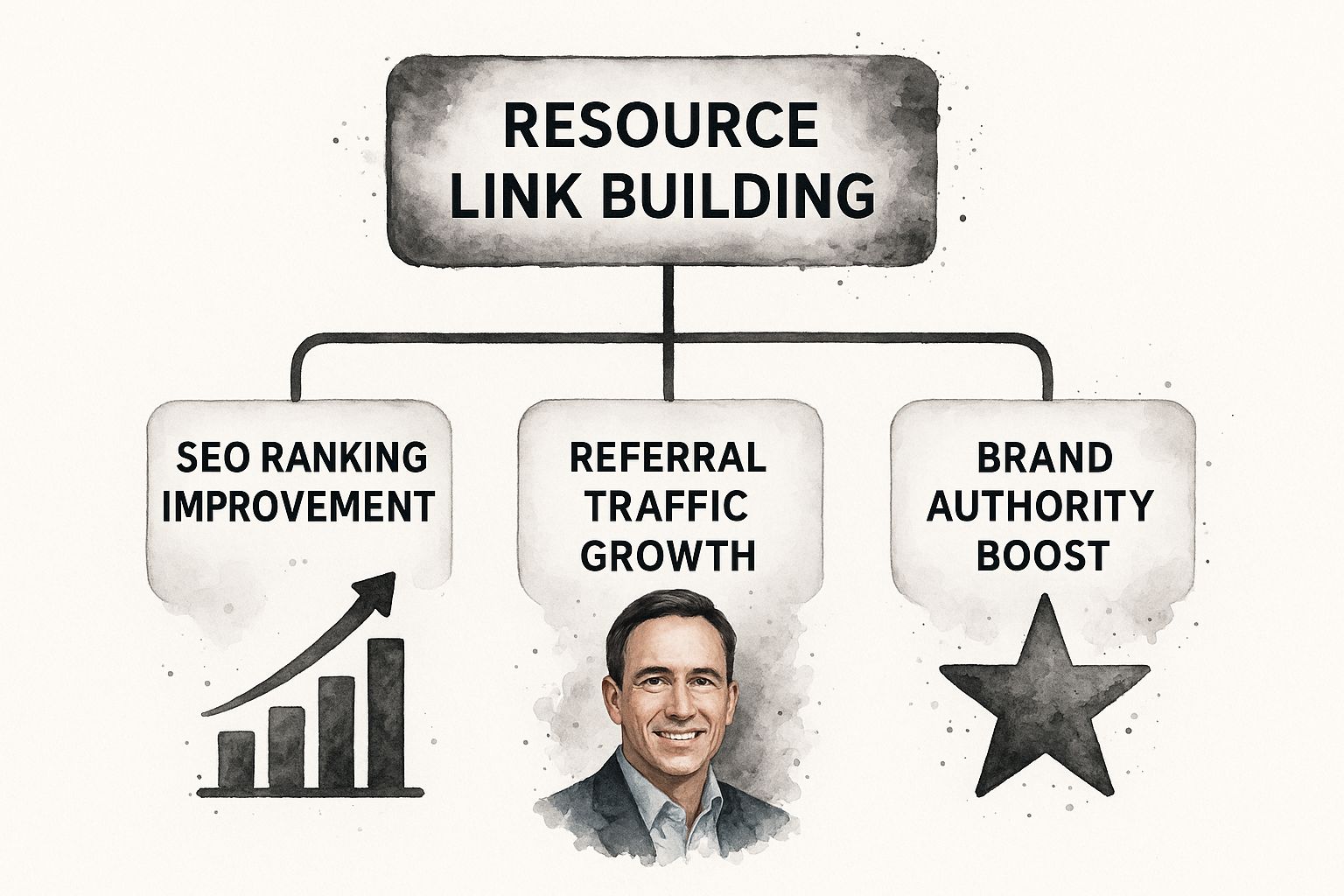Resource link building is all about creating something so valuable—like a killer guide, a one-of-a-kind tool, or your own original research—that other websites want to link to it. Instead of begging for backlinks, you're earning them by offering up something genuinely useful. It's a game-changer for establishing your credibility and authority.
The Power of Becoming an Essential Resource
Think of it like this: you're not just another voice in the crowd; you're building the definitive library on a specific topic. This completely flips the script. You shift from asking for a favor to offering real value, which makes this one of the most sustainable and powerful SEO strategies out there.
These aren't just random links, either. They're editorial stamps of approval from other site owners who see your content as a must-share for their own audience.
Building More Than Just Links
A smart resource link building campaign delivers a ton of benefits that go way beyond just collecting backlinks. Yes, these high-quality links are powerful signals that tell search engines you're a big deal, directly boosting your rankings. But the good stuff doesn't stop there.
- Boosted Brand Authority: When respected sites in your space link to you, some of their credibility rubs off. You become known as a trustworthy source of information.
- Increased Referral Traffic: Every single link is a new doorway for a relevant audience to find you. Beyond just SEO, this is a great strategy for anyone figuring out how to get more website traffic from sources that actually matter.
- Long-Term Asset Value: This is the best part. A truly great resource isn't a one-off win. It can keep pulling in links and traffic for years with very little extra work, giving you a fantastic return on your initial effort.
This image really drives home how creating one great asset leads to a cascade of positive results.

You can see how it all flows together—from the initial creation to the SEO boost and, finally, to lasting brand growth.
The core idea is simple but incredibly effective: Create something so good that other experts feel compelled to share it. This transforms link building from a chore into a genuine opportunity to build relationships.
Ultimately, resource link building is about playing the long game. You're not just chasing vanity metrics; you're weaving your website into the very fabric of your industry. By becoming that indispensable source, you build a competitive moat that's tough for anyone else to cross, securing a digital presence that’s both prominent and built to last.
How to Create an Irresistible Linkable Asset

Let’s get one thing straight: the secret to a great resource link building campaign isn't your outreach email. It's the asset you're pitching.
Think of your linkable asset as the main event—the blockbuster movie. Your outreach is just the trailer. If the movie is a masterpiece, people will line up to see it and tell their friends. If it's a flop, no amount of marketing will save it.
The goal here is simple: create something so genuinely useful that other site owners feel like they're doing their own audience a favor by linking to you. This means pushing past "good enough" content and aiming for something truly definitive.
Identify and Fill a Content Gap
The best linkable assets give an audience something they desperately need but can’t seem to find anywhere else. This is what we call a "content gap." Finding one is like discovering an unmarked, paved shortcut on a popular, rocky hiking trail. People will naturally start using it.
So, how do you find these gaps? Start by looking at the top-ranking content for your target topics. What questions are they leaving on the table? Where is the information just plain wrong, outdated, or confusing?
Your job is to create something that is 10x better than what's currently out there. I don't just mean longer. I mean more thorough, better designed, easier to navigate, and packed with more value. Nailing this part makes the outreach process feel less like begging and more like offering a gift.
A truly great linkable asset doesn't just answer a question; it becomes the definitive answer. It serves as a permanent, go-to resource that people bookmark, share, and, most importantly, link to repeatedly.
Of course, for an asset to get links, it also needs to be visible in the first place. That’s why understanding the crucial role of content in SEO is non-negotiable. This ensures the people you’re pitching can immediately see its authority and value.
Choose a Proven Format for Your Asset
While your topic is king, the format is the castle it lives in. The right format can make your information incredibly easy to consume, share, and—most importantly—link to. Some formats are just natural link magnets because they serve as evergreen utilities for other creators.
Here are a few formats that consistently knock it out of the park:
- Ultimate Guides: These are the monster, deep-dive pieces that cover a subject from every conceivable angle. They aim to be the last click someone needs to make on a topic.
- Original Research and Data Studies: When you publish unique data from a survey or experiment, you become the primary source. Anyone who wants to cite your findings has to link to you. It’s that simple.
- Free Online Tools or Calculators: Interactive assets that solve a real problem are link-building gold. A simple mortgage calculator or a nifty headline analyzer can attract links passively for years because they're genuinely helpful.
- Curated Resource Lists: A well-organized page that lists the absolute best tools, articles, or resources on a topic can become a go-to hub for an entire community. If your list is the most complete one out there, it's a natural link target.
Design for Maximum Impact
You could write the most brilliant, insightful content in the world, but if it's trapped in an ugly, hard-to-read design, it's dead on arrival. A clunky layout screams "untrustworthy" and will kill your link-building chances before you even send the first email.
Treat your asset like a standalone product. It needs a clean, user-friendly layout that looks and works great on any device. In fact, many of the same principles that make for high-converting landing pages apply here, because it's all about user experience.
At the end of the day, creating an irresistible asset comes down to being strategically generous. Solve a real problem for a specific audience, do it better than anyone else, and present it in a way that’s a joy to use. When you do that, the asset practically markets itself.
Finding and Qualifying High-Value Link Opportunities

Okay, you’ve created a genuinely fantastic piece of content—a real linkable asset. Now what? Your next mission is to find its perfect home on the web.
This part of the process is called prospecting, and it’s a mix of art and science. You're hunting for high-quality resource pages where your content doesn't just fit, but actually makes the page better.
Think of yourself as a librarian. You wouldn't just toss a new book onto any random shelf. You’d find the right section, in the right library, where people are already hungry for exactly what that book offers. That’s our goal here: finding opportunities that will actually move the needle.
Mastering Prospecting Techniques
The first step in finding these digital libraries is knowing where to look. Sure, you could just Google your topic and cross your fingers, but a systematic approach will get you much further, much faster. The best way forward is a combination of smart search queries and a little bit of competitor snooping.
One of the most direct ways to find resource pages is by using advanced Google search operators. These are simple commands you can tack onto your search to filter the results and uncover some real gems.
Here are a few of my go-to search strings to get you started:
* Your Keyword + "resources"
* Your Keyword + "helpful links"
* Your Keyword + inurl:links
* Your Keyword + "best sites"
These queries tell Google to pinpoint pages that use terms like "resources" or "links," which are exactly the kinds of pages you want to be on. Of course, this all starts with knowing what your target keywords are. If you're fuzzy on that, understanding how to do keyword research is a crucial first step that will guide your entire strategy.
Analyzing Competitors for Hidden Opportunities
Here's another trick that's incredibly effective: see who's linking to your competitors. If a quality site linked to their resource page, there's a very good chance they'll be open to linking to yours—especially if yours is better.
This is where tools like Ahrefs or SEMrush become your best friends. Just pop a competitor's URL into their backlink analysis tool, and you can filter the results to find pages with words like "resources" or "links" in the title or URL. Boom. You've just generated a pre-qualified list of high-potential targets.
This intelligence-driven approach is what modern SEO is all about. It’s no surprise that digital PR, which often involves creating and promoting valuable assets like these, has become the dominant link building tactic, used by 48.6% of experts.
Qualifying Your Prospects Like a Pro
Finding a potential target is only half the battle. The next, and arguably more important, step is qualification. You have to vet every single opportunity to make sure it's worth your time. Pitching a low-quality or irrelevant site isn't just a waste of an email; it can ding your brand's reputation.
A great link isn't just a link; it's an endorsement from a reputable source. Quality over quantity is the guiding principle of successful resource link building.
Before you even think about adding a site to your outreach list, you need to ask a few critical questions:
- Is the page topically relevant? The page linking to you should be closely related to your content's topic. A link from a top marketing blog to your social media guide? Golden. A link from a pet grooming site? Not so much.
- Does the site have real authority? Use SEO tools to check metrics like Domain Rating (DR) or Domain Authority (DA). These scores aren't perfect, but they give you a quick snapshot of a site's backlink profile and overall clout.
- Does the page link out to other high-quality external sites? Take a look at the other links on the page. Are they pointing to trusted, non-spammy websites? Remember, you're judged by the company you keep online.
- Is the website actively maintained? Look for recent blog posts or signs of life. An abandoned site isn't likely to reply to your email, and a link from a digital graveyard carries very little weight.
By being ruthless with this filtering process, you'll build a highly targeted list of prospects. These are the sites that are not only likely to respond but will also give you a link that makes a real impact on your rankings and traffic.
Crafting Outreach That Actually Gets a Response

You’ve built an amazing resource and found the perfect pages to feature it. Now for the moment of truth: the outreach email. This is precisely where most resource link building campaigns completely fall apart.
Sending a generic, robotic email is like trying to have a conversation in the middle of a rock concert. You’re just adding to the noise. The secret isn’t sending more emails; it’s about sending better ones built on value, personalization, and a genuine human touch. The goal is to make the site owner feel like you’re doing them a favor, not asking for one.
And here’s the good news: the people who manage these pages are usually on the lookout for great new content. Your job is simply to make it a no-brainer for them to say "yes."
The Psychology of a Great Pitch
Before you type a single word, get your head in the right space. The person on the other end is busy. They get dozens—if not hundreds—of these emails every single day and have a finely tuned spam detector. Your email has to slice through that clutter instantly.
Every part of your email, from the subject line down to your signature, needs to build trust and show them what's in it for them. It’s all about proving you’ve done your homework and that your resource will genuinely make their page better for their readers.
It’s a tough crowd out there. One analysis found that only 8.5% of cold emails ever get a backlink, mostly because editors are just swamped. But that same study showed personalized content gets 33% more engagement, and sending a single follow-up can literally double your response rate. You can see the full statistical breakdown of modern link building tactics to understand just how much these little details matter.
Building Your Outreach Email Step-by-Step
A killer outreach email isn’t complicated, but it is strategic. It follows a simple, logical flow that respects the reader's time while making a compelling case.
1. Nail the Subject Line Your subject line has one job and one job only: get the email opened. Keep it short, personal, and intriguing without sounding like clickbait.
- Bad: "Link Request" or "Content for your site"
- Good: "Question about your [Topic] resources page"
- Even Better: "A resource for your [Page Name] page"
2. The Personalized Opening Start by showing you're a human who actually visited their site. Reference the specific resource page you're talking about and mention something you genuinely liked. This one tiny step instantly separates you from the bots.
3. The Value Proposition (The "Why") This is the heart of your email. Get straight to the point. Explain that you created a resource on a related topic and immediately thought of their page as a great home for it.
Your pitch has to be framed around what’s in it for them. How does adding your link make their resource page more valuable to their audience? Always lead with their benefit, not yours.
4. Introduce Your Asset Drop the link to your resource with a one-sentence hook that explains what makes it stand out. For example, "It’s a complete guide to [Topic], and it even includes a free checklist that other guides don't offer."
5. The Gentle Suggestion Don’t make them think. Gently suggest where your link might fit. Something like, "I saw you have a section on '[Section Name],' and thought this might be a great addition there," does the heavy lifting for them.
The Art of the Follow-Up
Not everyone will reply to your first email. That’s totally fine. People are busy, and inboxes are chaotic. A polite, quick follow-up about a week later is an absolute must.
This isn't a guilt trip. Keep it light and simple. A quick note like, "Just wanted to bring this back to the top of your inbox in case it got buried," is often all it takes to get things moving. This simple act can dramatically boost your success rate, turning a "no response" into a definite "yes."
Common Resource Link Building Mistakes to Avoid
https://www.youtube.com/embed/2Lv3tgSFyXI
Even the sharpest resource link building campaigns can hit a snag if you aren't careful. Getting this strategy right means knowing the common traps that will absolutely drain your time, budget, and morale. Think of this as your field guide for sidestepping the most frequent—and costly—blunders.
And learning from these mistakes is critical, because let's be honest: link building is tough. A recent survey from Citation Labs found that only 29% of SEO pros feel their link building is actually working. Even more telling? A whopping 66% said their single biggest challenge was just picking the right tactics. That survey reveals a massive gap between what people want to do and what gets done.
Getting ahead of these pitfalls from the start is how you build a campaign that not only works but lasts.
Creating a "Good Enough" Asset
This is the big one. The absolute number one mistake is pouring time and effort into a resource that’s just… fine. "Good enough" is a death sentence in content marketing. It just adds to the internet's background noise and gives a busy site owner zero reason to link to you. Remember, you're asking them to put their stamp of approval on your work. A mediocre asset makes them look bad.
Your goal needs to be much, much higher. You should be aiming to create the definitive resource on the topic. It should be the guide you wish you had when you were first learning. If your asset isn't obviously better, more thorough, or easier to use than what's already ranking, your outreach emails are DOA.
Targeting Irrelevant or Low-Quality Websites
Another classic mistake is chasing any link you can get your hands on, no matter where it comes from. A link from a spammy, irrelevant website doesn't just do nothing for your SEO—it can actively harm it. Google and other search engines are smart enough to look at the company you keep online.
This is why you have to be ruthless when qualifying prospects. For every single site, ask yourself:
- Is this website actually related to my resource's topic?
- Does this site have a real audience and a solid reputation?
- Are they linking out to other credible sources, or is it just a messy page full of random links?
A single link from a high-authority, relevant site is worth more than a hundred junk links. Your prospecting should be a hunt for quality and a perfect fit, not just a numbers game.
Sending Impersonal and Spammy Outreach
Your outreach email is your first and often only impression. A generic, templated message that practically screams, "I am a robot who wants a link," gets deleted in seconds. Site managers get dozens of these every single day, and they can spot a lazy, automated pitch from a mile away.
Personalization isn't optional; it's the whole game. Show them you've done your homework. Mention the specific resource page on their site, explain why your asset would genuinely help their specific audience, and prove you've actually spent more than ten seconds on their website. This little bit of human effort is what turns a demand into a helpful, collaborative suggestion. For more deep-dives into outreach and other growth strategies, the RebelGrowth blog is packed with info.
Having Unrealistic Expectations
Finally, you have to understand what this strategy is—and what it isn't. Resource link building is a long-term play, not an overnight hack. It takes real time to create an amazing asset, find the right people to show it to, write personalized emails, and then wait for the SEO results to kick in.
Expecting to land dozens of top-tier links in the first month is a surefire way to get discouraged and quit. Set realistic goals, be patient, and focus on building real relationships, not just collecting links. The value here compounds. The links you build this way deliver authority and sustainable traffic for years to come.
Your Essential Resource Link Building Toolkit
Let's be honest: you can try to run a resource link building campaign manually. But it's like trying to build a house with a hammer and a handsaw. You might get there eventually, but it's going to be slow, painful, and inefficient.
The right tools are a massive force multiplier. They save you hundreds of hours and, more importantly, they uncover killer opportunities you would have completely missed otherwise. This isn't about collecting a bunch of shiny new software subscriptions. It's about building a streamlined workflow where each tool has a specific job, moving you from one stage to the next with speed and precision.
Tools for Prospecting and Analysis
First things first, you have to find those golden resource pages. Just Googling around will only get you so far. To do this like a pro, you need platforms that can crawl and analyze the web at a massive scale.
- Ahrefs & SEMrush: These are the undisputed heavyweights in the SEO world for a reason. Their backlink analysis tools are absolutely essential. You can plug in a competitor's resource and instantly see a list of every single site that links to it. That's a pre-qualified, high-value list of targets handed to you on a silver platter.
- Content Explorer (Ahrefs): This feature is a goldmine. It lets you find pages that have linked to content similar to yours in the past. This is how you identify the "proven linkers" in your niche—the sites with a track record of actually adding links to great resources.
Using these platforms, you can quickly build a huge list of potential link targets. But then you have a new problem: how do you manage it all?
Software for Outreach and Campaign Management
Once your prospect list is ready, your success hinges on organization. Just firing off emails from your regular Gmail account is a one-way ticket to chaos. You need a dedicated system.
The most successful link building campaigns are built on systems, not just raw effort. Specialized outreach tools turn a messy, manual grind into a well-oiled machine, letting you personalize at scale and actually track what's working.
This is where industry-standard platforms like Pitchbox and BuzzStream come in. They are built from the ground up for this exact process. They bring your prospecting, email outreach, and follow-ups all under one roof. This lets you automate the tedious stuff (like scheduling follow-ups) while still personalizing your emails so they don't sound like a robot wrote them.
Of course, you also need a way to find who to email in the first place. Sending your pitch to a generic info@ address is almost always a waste of time. Tools like Hunter or Snov.io are fantastic for sniffing out the right person's email address, which drastically increases your odds of getting a response.
If you're looking to explore other technologies that might fit into your marketing stack, you can browse a comprehensive marketing tools directory. By combining these tools, you're not just sending emails—you're running a professional, powerful, and scalable resource link building campaign.
Answering Your Top Questions About Resource Link Building
Even with the best game plan, you're bound to run into some practical questions once you're in the trenches of a resource link building campaign. Getting straight answers will help you set realistic expectations and fine-tune your approach for the best possible outcome.
Let's dive into some of the questions I hear most often.
How Many Links Can One Resource Page Actually Get?
This is the classic "it depends" scenario, but we can definitely narrow it down. A truly groundbreaking, one-of-a-kind resource can become an industry touchstone, passively pulling in dozens or even hundreds of links over its lifetime. Think of those definitive guides you see referenced everywhere.
But for a typical, well-run campaign? A more realistic target is anywhere from 5 to 20 high-quality links.
The final tally really hinges on a few things: * The Asset's Quality: Is it genuinely head and shoulders above what's already out there? Be honest with yourself. * The Niche's Size: A wide-open space like "digital marketing" has a much larger pool of potential linkers than a niche like "vintage fountain pen repair." * Your Outreach Hustle: The scale and, more importantly, the quality of your outreach will make or break your results.
What's a Good Success Rate for Outreach?
Here's where reality often hits hard. A "good" success rate for resource page outreach is probably lower than you're hoping for. If you're turning 3% to 8% of your personalized emails into live links, you're not just doing well—you're crushing it.
Let that sink in. For every 100 well-researched, personalized emails you send, you might land between 3 and 8 links.
Don't get discouraged by what seems like a low conversion rate. The name of the game isn't getting a "yes" from everyone. It's about getting a "yes" from the right sites. A single, powerful link from an authoritative page is worth more than a boatload of rejections.
How Long Does It Take to See SEO Results From These Links?
Patience, my friend. In the world of resource link building, patience is everything. You might see a little referral traffic almost immediately after a link goes live, but the real SEO payoff takes time to build up.
As a rule of thumb, you can expect to see noticeable movement in your search rankings within 3 to 6 months after building a solid base of links.
Search engines need time to crawl these new links, figure out how valuable they are, and then recalculate your site's overall authority. This is a long-term investment in your site's foundation, not a quick hack for overnight rankings.
Should I Ever Pay for a Link on a Resource Page?
Let me make this simple: No.
Paying for a link to be placed on a resource page goes against Google's webmaster guidelines and can land you in hot water. The whole philosophy behind this strategy is to earn links because your content is genuinely valuable and helpful.
If a site owner replies to your outreach asking for a fee to add your link, take it as a giant red flag. Just politely decline and walk away. Authentic, earned links are the only ones that provide lasting, sustainable SEO value.
Ready to build a powerful online presence that attracts links and customers? rebelgrowth gives you the AI-powered tools to create standout content, manage your marketing, and dominate search engine results. Explore what’s possible at https://rebelgrowth.com.
